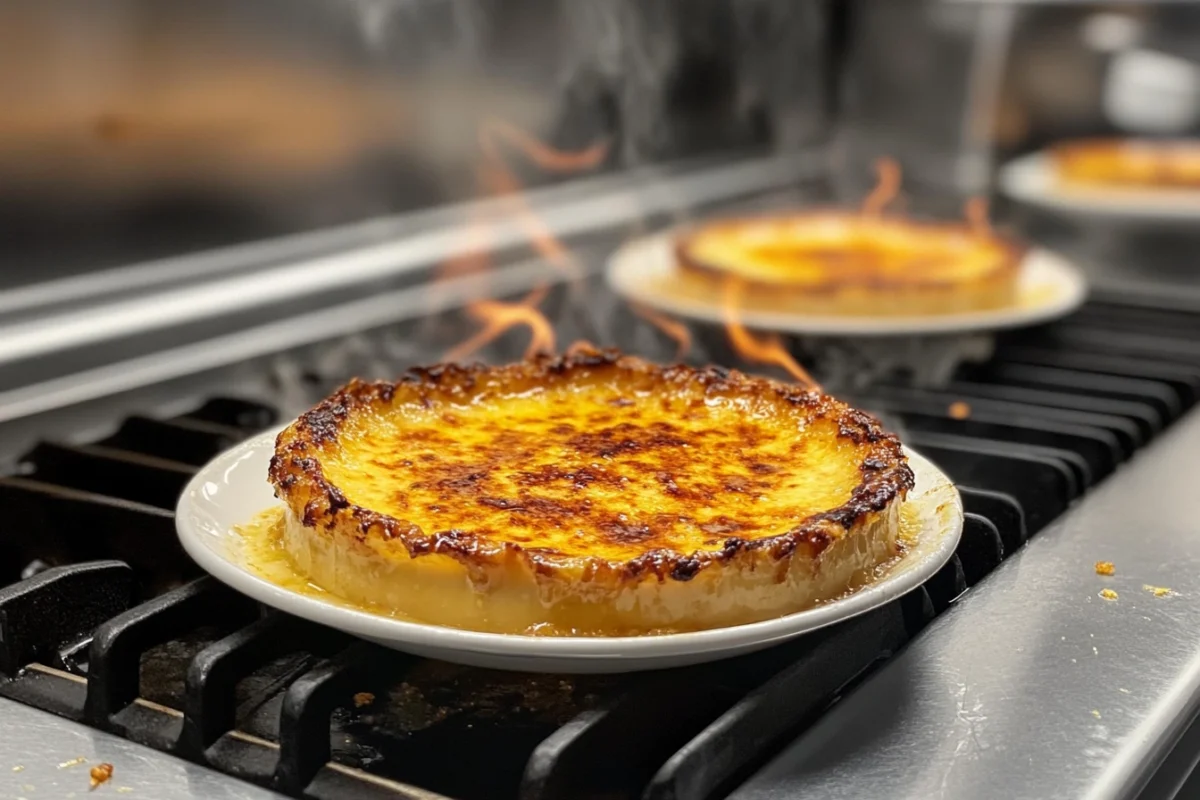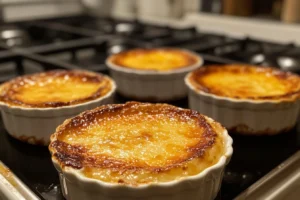What type of cream is best for crème brûlée? This article explores ideal cream choices for a perfect crème brûlée. We will examine cream options and explain why each affects the final dish. Cream, therefore, plays a critical role.
Choosing the Right Cream for Your Crème Brûlée
Making a crème brûlée that’s both silky and smooth relies greatly on choosing the right cream. The type of cream you use can dramatically change the texture and taste of this classic dessert. Therefore, understanding your options is important. We will explore the different types of cream and how each affects your crème brûlée. Indeed, the right cream can truly elevate this dessert.
Understanding Different Types of Cream
Cream comes in various forms, each with a unique fat content. Heavy cream, for example, has a high-fat content that gives richness. On the other hand, light cream has a lower fat content. Consequently, it leads to a lighter result. Therefore, it’s key to understand these differences. The fat content directly impacts the texture of your crème brûlée. Furthermore, the flavor profile will vary depending on the type of cream you choose. Ultimately, the type of cream is key to a great result.
Heavy Cream: The Classic Choice for Crème Brûlée
Heavy cream is often considered the best cream for crème brûlée. The higher fat percentage, usually around 36% or more, creates a wonderfully smooth and decadent texture. Additionally, heavy cream lends a rich flavor that’s perfect for this dessert. Because of its high-fat content, heavy cream also sets more firmly. This prevents a runny or overly soft crème brûlée. As a result, your dessert has a perfect balance of firmness and creamy texture. Heavy cream is, therefore, the classic choice.
Heavy Whipping Cream as an Alternative
Heavy whipping cream is another option for making crème brûlée. Although very similar to heavy cream, heavy whipping cream may have a slightly lower fat content. It typically sits around 30% to 36%. Nonetheless, the difference is minor. Therefore, it can often be used interchangeably with heavy cream in crème brûlée. This cream provides a similar rich and smooth texture. Moreover, it ensures that your crème brûlée is both creamy and satisfying. The slight difference in fat content is usually not noticeable.
The Importance of Freshness in Cream
The freshness of your cream is also important. Fresh cream will taste better and perform better in recipes. Consequently, it’s always best to check the expiration date. Storing cream correctly is also key. This helps to maintain its quality. It is best kept refrigerated and sealed properly. Furthermore, use it soon after opening it. Therefore, always prioritize fresh cream for your recipe.
How Different Cream Options Affect Crème Brûlée
The cream used impacts more than just the texture. It also plays a crucial role in the overall flavor and stability of the dessert. Different types of cream yield distinct results. Therefore, the choice of cream is fundamental for achieving the desired crème brûlée. We will examine how various cream options contribute to the final product. The selection of cream, therefore, is not arbitrary.
Impact of Fat Content on Texture
The fat content is the main factor that dictates the texture of your crème brûlée. Heavy cream, with its higher fat percentage, produces a very dense and smooth custard. Light cream, having less fat, results in a thinner, less rich consistency. Therefore, if you prefer a classic, decadent crème brûlée, using heavy cream or heavy whipping cream is best. However, using a light cream can lead to a less stable, more liquid crème brûlée. The difference is, therefore, significant.
Flavor Profile and Cream Choices
The cream also contributes to the flavor profile of the crème brûlée. The high-fat content of heavy cream provides a rich, creamy taste. It perfectly balances the sweet custard base. Light cream, however, can make the dessert taste lighter and perhaps a bit less satisfying. Therefore, choosing a cream with a higher fat content is key for the best flavor. The subtle flavor of the cream should enhance, not detract from, the other flavors in the dessert. Ultimately, the right cream complements the overall taste.
The Role of Cream in Setting Properly
The high-fat content of heavy cream is crucial for the crème brûlée to set correctly. This type of cream provides the structure needed for the custard to firm up without becoming too dense. Alternatively, using light cream can result in a crème brûlée that doesn’t set properly. It might also be too runny. Therefore, using the right type of cream ensures the custard will have the perfect consistency and structure. Using heavy cream will provide the best results.
Understanding Over-Whisking and Cream
Over-whisking the cream can affect the texture of your crème brûlée. It’s important not to over-aerate the cream. Over-whisking can introduce too much air, leading to a less smooth result. Furthermore, it can impact the setting of the custard. Therefore, mix the cream gently with the other ingredients. Do not use an electric mixer, unless is absolutely necessary.
Cream Alternatives and Considerations for Crème Brûlée
While heavy cream is the traditional choice, there are times when you might consider alternatives. Personal preferences or dietary needs can influence these choices. Therefore, understanding these alternatives is important. We will explore several options. We will discuss what to consider when selecting an alternative cream for your crème brûlée. Cream substitutions, therefore, require careful attention.
Using Half-and-Half in Crème Brûlée
Half-and-half, which is a mixture of milk and cream, has a lower fat content than heavy cream. Therefore, it isn’t the best choice for crème brûlée. If you choose to use half-and-half, you might need to adjust the recipe. Adding extra egg yolks or a thickening agent can compensate for the lower fat. However, the texture and taste will be slightly different. Half-and-half can result in a lighter, less rich dessert. The outcome will, therefore, be different.
Light Cream for a Lighter Option
Light cream can also be used, but it’s not recommended for a classic crème brûlée. It contains even less fat than half-and-half. Consequently, the final product will be less creamy. Furthermore, it may not set correctly. As a result, the dessert can become too runny. Using light cream can be a viable option for someone looking for a lighter version of the dessert. Nevertheless, it is important to understand its limitations. Light cream, therefore, requires special attention.
Plant-Based Cream Options
For those who avoid dairy, plant-based cream alternatives are available. Coconut cream, for example, can work in crème brûlée. Its high-fat content can help achieve a similar texture to heavy cream. However, coconut cream will add a coconut flavor to the dessert. Therefore, you should choose this cream option if you want that taste. Additionally, other plant-based cream options may also work. Just ensure they have a high-fat content. Soy cream and cashew cream can also be used.
Adjusting Recipes for Cream Substitutes
When you use a cream substitute, adjusting the recipe may be necessary. For instance, plant-based cream might need a thickening agent to mimic heavy cream. Moreover, the taste may differ. Therefore, experimenting is key. Before making the full recipe, do a small batch test. This ensures that your substitutions work well. Adjustments ensure the best results. You may need to add cornstarch or agar agar. This helps to achieve a better set.
Understanding the Impact of Sugar Content
The sugar content in your crème brûlée can affect how the cream works. Using too much sugar can prevent the custard from setting correctly. Therefore, measure the sugar accurately. Follow the recipe closely. The sugar content impacts the cream’s overall performance. Sugar can make the custard too liquid or too stiff. This shows how balanced the recipe needs to be.
Tips for Perfect Crème Brûlée with the Right Cream
Using the best cream for crème brûlée is only one part of the equation. Other techniques are crucial for creating a perfect dish. We will discuss other important tips to help you succeed. We will cover key steps, from baking to achieving that perfect sugar crust. These tips can help elevate your crème brûlée to the next level. Each detail will matter.
The Importance of the Baking Process
The baking process is very important for crème brûlée. Baking at a low temperature in a water bath is essential. This method allows the custard to cook gently and evenly. It prevents the edges from cooking too quickly. This will help create a smooth, silky texture. Baking at a low temperature is, therefore, key. Also, ensure you use the right oven rack. Placing the ramekins in a large baking dish and filling it with hot water, is crucial. This creates a humid environment that helps the custard to set smoothly.
Achieving the Perfect Sugar Crust
The caramelized sugar crust is a signature element of crème brûlée. A kitchen torch is usually used to melt and caramelize the sugar. You can, however, also use your oven’s broiler. Ensure that the sugar layer is evenly spread. Do not burn the sugar while caramelizing it. A little practice will help you master this technique. Remember, a golden brown color is what you want. Furthermore, ensure the sugar layer is thin and even. Also, avoid touching the sugar with wet hands.
Cooling and Serving Crème Brûlée
After baking, crème brûlée needs to be cooled completely. The chilling process allows the custard to set. For best results, chill for at least two hours. After chilling, you can then add the sugar layer and caramelize it just before serving. Serving the crème brûlée chilled with a warm, crisp sugar crust provides a wonderful contrast of flavors and textures. This contrast is what makes the dessert special. Always let the crème brûlée cool slowly. Avoid sudden changes in temperature.
Using High-Quality Cream
Using good-quality cream is also important for the final result. Cream that is fresher will taste better. It will also ensure a better texture. Therefore, choosing a reputable brand is also important. Fresh cream ensures that your crème brûlée is both flavorful and delicious. Always check the expiration date before buying. Additionally, consider cream from local producers when available. They often have a richer flavor.
Exploring Flavor Variations
While classic crème brûlée uses cream, egg yolks, and sugar, it can be modified. Variations include infusing the cream with different flavors. Vanilla is a classic choice, but you can also use citrus zests, spices, or coffee. These changes add layers of complexity to the flavor profile. When you add a flavor, the cream needs time to infuse properly. Infusion time is, therefore, essential. You can also use extracts to intensify the flavor.
Adding Extracts and Spices
Using extracts and spices can also enhance the flavor of your crème brûlée. A small amount of vanilla extract is a classic addition. However, you can experiment with almond, lemon, or other extracts. Spices such as cinnamon, nutmeg, or cardamom can add a warm, aromatic note. Adding these in small amounts is key. Too much spice or extract can overpower the delicate flavor of the cream. Therefore, use these with care.
Using Quality Eggs
The quality of your eggs also impacts your crème brûlée. Fresh, high-quality eggs will result in a better flavor and texture. The egg yolks provide richness. The correct ratio of egg yolks to cream is key to achieving a perfect custard. Always use fresh eggs, if possible. Store them properly in the refrigerator.
Frequently Asked Questions About Cream for Crème Brûlée
Here are some commonly asked questions about cream in relation to crème brûlée:
What happens if I use light cream instead of heavy cream?
If you use light cream, your crème brûlée will likely be thinner. It may not set properly. The texture will be less rich. For best results, it’s better to use heavy cream. The difference in results is very clear. Light cream lacks the fat content necessary.
Can I use half-and-half for crème brûlée?
Half-and-half can be used, but it’s not ideal. You may need to adjust the recipe. Using half-and-half can lead to a less creamy result. Also, it might not set properly. It’s better to use a higher fat content cream. The final result will be significantly improved.
Are there dairy-free alternatives for cream in crème brûlée?
Yes, coconut cream is a good dairy-free alternative. Ensure you pick a brand with high-fat content. However, remember that plant-based options may alter the taste. Other options such as cashew cream or soy cream may also work. Consider testing them.
Is heavy whipping cream the same as heavy cream for crème brûlée?
Heavy whipping cream and heavy cream are similar. They can generally be used interchangeably. They both have a high-fat content. Therefore, they provide a rich, smooth texture in crème brûlée. The difference in fat content is usually minimal. The results are very similar.
Conclusion
In conclusion, the choice of cream is critical when making crème brûlée. Heavy cream, with its high fat content, is the best choice for a classic, rich, and smooth dessert. Heavy whipping cream is a close substitute, and it works well. Light cream and half-and-half can be used, but they will not give you optimal results. Plant-based cream alternatives can be good options. However, they may affect the flavor. Therefore, when choosing the cream, consider the texture and taste you want. A little bit of attention to these details ensures a perfect crème brûlée every time. Remember, the right cream will make a world of difference. The difference in the final product will be significant.
For more culinary secrets and dessert inspiration, explore Crème Brûlée Secret and other related articles on RecipesCaia!




